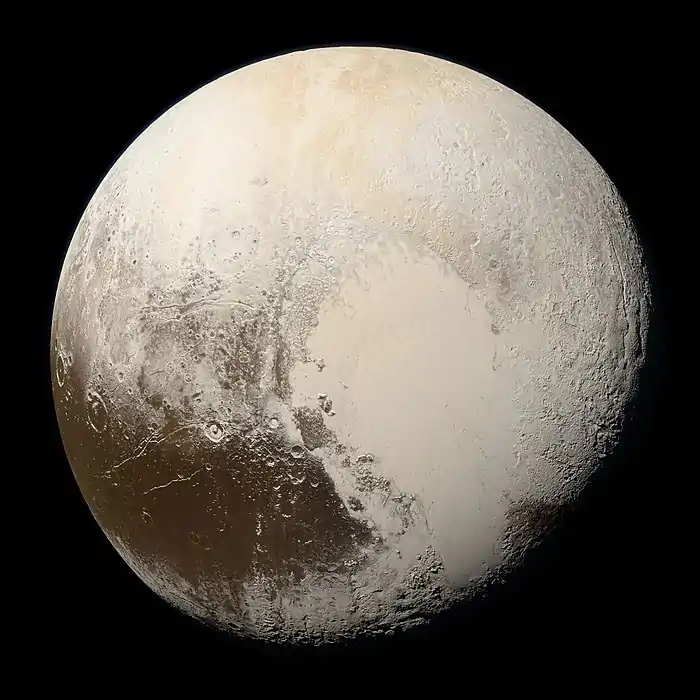2010 KZ39
2010 KZ39 is a trans-Neptunian object orbiting the Sun as a detached object in the outer reaches of the Solar System. It is likely a dwarf planet as it measures approximately 600 kilometers in diameter.[10][11][7] The object was first observed on 21 May 2010 by astronomers Andrzej Udalski, Scott Sheppard, M. Szymanski and Chad Trujillo at the Las Campañas Observatory in Chile.[1][3]
| Discovery [1][2][3] | |
|---|---|
| Discovered by |
|
| Discovery site | Las Campañas Obs. (first observed) |
| Discovery date | 21 May 2010 (first observed) |
| Designations | |
| 2010 KZ39 | |
| Orbital characteristics [4][5] | |
| Epoch 16 February 2017 (JD 2457800.5) | |
| Uncertainty parameter 5 | |
| Observation arc | 1.83 yr (669 days) |
| Aphelion | 47.825 AU |
| Perihelion | 42.965 AU |
| 45.395 AU | |
| Eccentricity | 0.0535 |
| 305.86 yr (111,714 days) | |
| 256.31° | |
| 0° 0m 11.52s / day | |
| Inclination | 26.032° |
| 53.118° | |
| ≈ 6 May 2110[6] ±5 months | |
| 313.91° | |
| Physical characteristics | |
| 0.10 (assumed)[7] | |
| 20.7[8] | |
Description

2010 KZ39 orbits the Sun at a distance of 42.9–47.8 AU once every 305 years and 3 months (111,504 days), similar to Makemake, Chaos and other bodies that circle the Sun in 6:11 resonance to Neptune. Its orbit has an eccentricity of 0.05 and an inclination of 26° with respect to the ecliptic.
Using the best-fit values for its orbit, it is expected to come to perihelion in 2109.[4] It has been observed 28 times over 3 oppositions and has an uncertainty parameter of 5.[1] As of 2016, is 46.1 AU from the Sun.[8] The body's spectral type as well as its rotation period remain unknown.
Brown assumes an albedo of 0.09 and magnitude of 4.5, resulting in an estimated diameter of 574 kilometers.[11] However, because the albedo is unknown and it a currently estimated absolute magnitude of 4.03±0.01,[9] its diameter could easily fall between 414 and 933 km[12] for an assumed albedo between 0.25 and 0.05, respectively.
References
- "(2010 KZ39)". Minor Planet Center. Retrieved 21 September 2016.
- "MPEC 2010-L38 : 2010 KZ39". IAU Minor Planet Center. 8 June 2010. Retrieved 3 December 2010.
- All four named discoverers are uncredited in sources.
- "JPL Small-Body Database Browser: (2010 KZ39)" (2012-03-20 last obs.). Jet Propulsion Laboratory. Retrieved 3 April 2017.
- Marc W. Buie. "Orbit Fit and Astrometric record for 10KZ39" (last observation: 2012-03-20 using 28 of 28 observations over 1.83 years). SwRI (Space Science Department). Retrieved 18 August 2011.
- JPL Horizons Observer Location: @sun (Perihelion occurs when deldot changes from negative to positive. Uncertainty in time of perihelion is 3-sigma.)
- "LCDB Data for 2010 KZ39". Asteroid Lightcurve Database (LCDB). Retrieved 3 April 2017.
- "AstDyS: 2010 KZ39 Ephemerides". AstDyS. Retrieved 7 April 2014.
- Benecchi, Susan D.; Sheppard, Scott S. (May 2013). "Light Curves of 32 Large Transneptunian Objects". The Astronomical Journal. 145 (5): 19. arXiv:1301.5791. Bibcode:2013AJ....145..124B. doi:10.1088/0004-6256/145/5/124. S2CID 54183985. Retrieved 3 April 2017.
- "Absolute Magnitude (H)". NASA/JPL. Retrieved 19 July 2011.
- Michael E. Brown. "How many dwarf planets are there in the outer solar system? (updates daily)". California Institute of Technology. Retrieved 14 August 2019.
- Dan Bruton. "Conversion of Absolute Magnitude to Diameter for Minor Planets". Department of Physics & Astronomy (Stephen F. Austin State University). Archived from the original on 23 July 2011. Retrieved 18 August 2011.
External links
- Large New Trans-Neptunian Object 2010 KZ39 Discovered (BAA Blog : 9 June 2010)
- OCKS: OGLE Carnegie Kuiper belt Survey (OCKS is a Southern sky survey searching for Kuiper Belt objects and dwarf planets)
- 2010 KZ39 at AstDyS-2, Asteroids—Dynamic Site
- 2010 KZ39 at the JPL Small-Body Database
_(cropped).jpg.webp)

